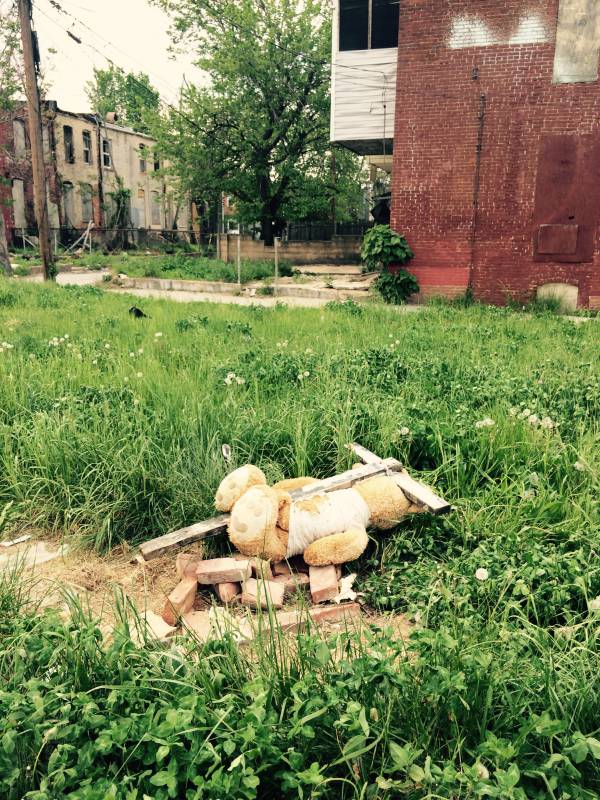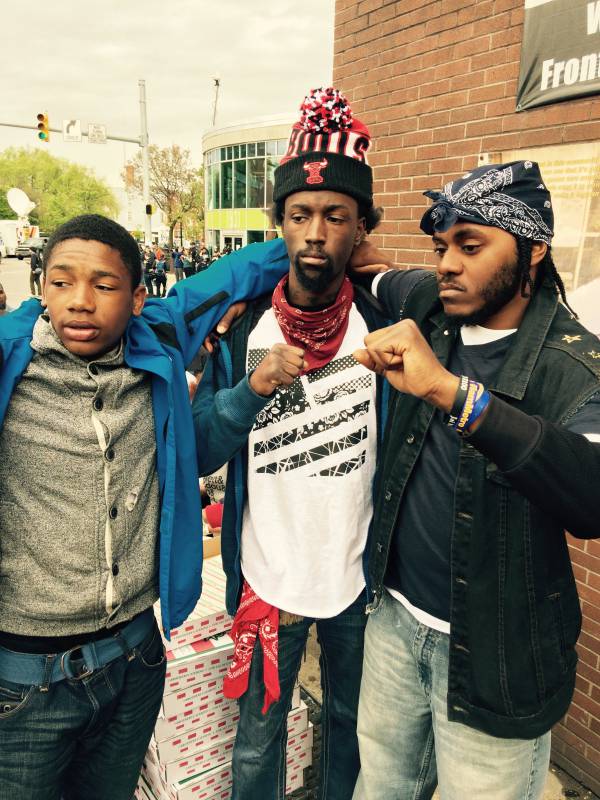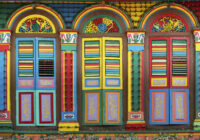What were the deep-rooted causes behind the uprising in Baltimore? [Click the image above or scroll down to view the mini gallery.]
“Baltimore is a troubled city, a city of lost souls.” Naisha Smith is only 25 years old, but she has an awareness that would escape even the most experienced of social observers. “The problems come when the citizens feel threatened … had they not rioted, the way they did, they would not have been heard. This is a build up from generations of constant anger.”
Her aunt, Renée Washington, a woman of sharp intelligence and inescapable warmth, who was sitting next to me in their Baltimore home, interrupted: “I agree with what the young people did, because these kids got tired of being another black statistic.”
She continued: “But if you never do anything, guess what? The next generation will be fighting the same fight we are fighting now, and it is time for it to stop.”
The candor in which they spoke about police violence was deeply unsettling. Attempting to justify my naiveté, I explained that I had just spent the past 11 years overseas. For me, the idea that in 2015 people still lived with this kind of fear was shocking. These are the same types of stories I grew accustomed to hearing in Iraq and Angola – not in the United States.
Only a few days earlier, I had met Renée at the headquarters of the People’s Power Assembly in West Baltimore — a community activist group organizing protests throughout the city. During our brief encounter, she displayed a distinct skepticism toward the charges just leveled against the six officers who killed Freddie Gray. In a lively office full of volunteers, some of whom traveled from all over the US, she plainly told me: “Baltimore never gave any justice to the folks police killed. This is just an attempt to quiet people down, pure and simple.”
Renée’s finance was also killed by the Baltimore police in 2000, in a well-publicized case.
The real story of what happened in Baltimore is with people like Renée, and how their perceptions have been shaped by years of mistreatment at the hands of the police. These are the feelings that truly fueled the unrest in Baltimore. And what soon became apparent was that the upheaval, far from being an opportunistic outburst of anger, was actually a carefully choreographed response. One that had been building over time, by young people looking to challenge a system that has consistently failed them.
Tired of Being Another Black Statistic
I saw this frustration vividly on the steps of the Baltimore War Memorial Building on May 1, only minutes after District Attorney, Marilyn Mosby, read the charges against the six officers. Community activist Jay Morrison, from the Young Minds Can Community Coalition, holding a megaphone, addressed the crowd: “This is not about civil rights, this is about human rights, how the police officers ignored that man’s [Freddie Gray] basic human rights …we treat terrorists better than we treat black people.”
Analyzing conflict in any country that is prone to violence would reveal unique similarities to Baltimore: a lack of access to jobs, education, opportunity, soaring income inequality, as well as state-sanctioned violence, tends to end in overt hostility – think the Arab Spring. And, given that the city of Baltimore has been involved in 317 lawsuits involving the police since 2011, resulting in $5.7 million worth of payouts, this is not a far-fetched assessment.
Furthermore, of at least 109 people have been killed by the police in Baltimore between 2010-14, 69% were black. And of the total number killed, black people were five times more likely to die from an encounter with the police. Half of these, almost 45%, were not armed with a weapon of any kind.
Given these facts, the shock from politicians, pundits and commentators that followed the riots is not only misplaced, but highly cynical.
Abandoned Buildings and Vacant Lots
After the protests and demonstrations were over, I traveled back to Baltimore to spend some time with Renée in an attempt to better understand the perspective of local residents. Her fiancé, Joey Wilbon, was killed after someone reported that he was stealing cars from the auto repair shop he owned. No police officers were ever charged with his murder.
She showed me the press clippings about her fiancé, as well as a book of old photos. “The police thought he was homeless, and of course they did not go to the people who called them — then they killed him.” There were clear discrepancies in the story told by the Baltimore police about what happened. A police spokesman said there was no sign of trauma, but when relatives eventually viewed the body, days later, there were bruises and swelling on his face. This follows a similar pattern, which exists to this day: One which portrays the victim as being unruly, before being processed on a fabricated charge and, in some instances, dying while in police custody.
A short time later, Renée took me around to some of the neighborhoods where the police had killed local residents, including Joey. Accompanying us was a woman named Sharon Black, who runs the People’s Power Assembly. A retired nurse, Sharon is every bit the committed community activist, having spent years on the front line of equality struggles in Baltimore.
Before we toured some of these neighborhoods, I asked Sharon where Baltimore was going to go from here, after the cameras leave and the media loses interest. Like a battlefield commander, she laid out a plan for what is going to happen next: “The phase we are in right now is demanding amnesty for the youth. There is very close to 500 people arrested during the past two weeks. So immediately coming to the defense of those arrested, and making sure there is a conviction and the police serve jail time are our short time priorities.”
“In the long-term, we are going to implement a ‘know your rights, cop watch’ campaign to train people in how to use cameras and patrol their own neighborhoods. We are also looking into the possibility of a charter amendment for the election of the police commissioner.”
Our first stop in East Baltimore was near Montford Avenue and Biddle Street. In 2012, a now-redundant special unit of the Baltimore police, called the Violent Crime Impact Section, also known as “knockers” by local residents, killed a man named Anthony Anderson in a vacant lot. The police claimed he was dealing drugs and died from swallowing a bag of heroin, but the medial examiner’s report listed the cause of death as “blunt force trauma,” which included eight broken ribs, lung bruises and spleen lacerations. His death was ruled a homicide, but no charges were ever filed against the police.
Only a sad memorial remains as tribute to Anthony Anderson. A stuffed bear, held up by some old wood, which we found laying on its side.
This area is notoriously impoverished with derelict houses lining narrow streets, which are in various states of collapse. Some estimates have indicated that there are upward of 16,000 abandoned buildings and 14,000 vacant lots in Baltimore, the same kind that Anthony Anderson was walking through when accosted by police in 2012. Young men occupy every corner, some selling drugs, some just milling about with little else to do. Unemployment for young men in this part of the city is at a staggering 37%.
The spot where Renée’s fiancé was murdered is little more than a small parking lot on the corner of Homewood and Bartlett, also in East Baltimore. This was the first time she had been back, since visiting it with Joey’s mother in 2005. She carried herself with a quiet resolve, but I could tell being back was upsetting for her. “It took months for his family to get the police report, months, because they couldn’t figure out what should be in it.” When I asked about the outcome, about justice for her or his family, she just shook her head. “There was nothing.” There is no monument for Joseph in this place.
As two young men walked by, Renée stopped them and asked what they thought about the Freddie Gray case. Both responded in great detail about how the legal proceedings were handled, including how the charges and potential prosecution could work. Impressed, I nodded my head in agreement, until I realized that this was probably due to first-hand experience of being arrested and maneuvering through the courts.
Around 92% of all marijuana arrests in Baltimore come from lower income communities, which is almost six times higher than white communities, even though drug use is comparable in both.
During our conversation, one of the young men conducted a drug deal in front of us.
In Order to Stop This Fighting, We Have to Stir Up the Peace
A few days before my tour of the city with Renée and Sharon, during the May 1 demonstrations, on the corner of Penn North, next to the CVS, which was ransacked during the riots, a young student named Tee Latrice told me: “In order to stop this fighting, we have to stir up the peace.”
Not long after, a local member from the Crips gang, handing out slices of pizza (pizza diplomacy never fails) also on the corner of Penn North, told me: “We ain’t got much, so sometimes, you got to cause some devastation to get your point across.” When I pressed him on what this meant, he simply said: “People care about shit getting burned down, why? This man’s dead.”
Once I heard this, I started hearing it everywhere: The idea that rioting and property destruction was somehow the story — not their lives that had been brutalized by an out-of-control police force. This theme soon started to connect a local narrative that was almost entirely overlooked for the more sensational aspects of media consumption. For the protesters, these two things were entirely linked, the destruction of property and the death of Freddie Gray. That was the entire point, not the consequence. To separate these things only reinforces the impression that the conditions which led to the upheaval in Baltimore were somehow irrelevant.
The one time I asked someone on the street about the looting, I was met with a look of complete incredulity, which seemed to say: “Is that your takeaway from this, the looting of a CVS?”
This concept is quite hard to understand, let alone relate to, especially for people who have been fortunate enough to never have been truly disenfranchised — not just in their own country, but also in their own communities. Reducing the enormity of this to mere abstractions like “rioting” and “looting” will only guarantee that episodes like this will continue to happen with increasing frequency.
For some commentators, the demonstrations and celebrations in Baltimore have been indicative of a certain perception — one which attempts to portray low income communities as uniquely subversive or antagonistic toward police.
This is an easy trap to fall into, more so, as income inequality and partisan politics drives communities further apart and challenges our ability to empathize with one another. The reality, however, is much more simple. Lower income communities have finally found some small degree of accountability, after years of police abuse. The same kind of accountability that is demanded by medium income communities throughout the US.
As the sun was going down, we walked over to a demonstration being conducted by a local church. Walking around the neighborhood in the shadow of a dilapidated school, which was vacant and crumbling, the pastor blessed the community and asked for the strength to rebuild. But not before blessing the city officials, the mayor and finally the police.
Renée just looked at me and said, “Maybe they should pray for those people who are killing our children.”
The views expressed in this article are the author’s own and do not necessarily reflect Fair Observer’s editorial policy.
Photo Credit: Landon Shroder
 We bring you perspectives from around the world. Help us to inform and educate. Your donation is tax-deductible. Join over 400 people to become a donor or you could choose to be a sponsor.
We bring you perspectives from around the world. Help us to inform and educate. Your donation is tax-deductible. Join over 400 people to become a donor or you could choose to be a sponsor.
1 comment
Leave a comment
You must be logged in to post a comment.
Support Fair Observer
We rely on your support for our independence, diversity and quality.
For more than 10 years, Fair Observer has been free, fair and independent. No billionaire owns us, no advertisers control us. We are a reader-supported nonprofit. Unlike many other publications, we keep our content free for readers regardless of where they live or whether they can afford to pay. We have no paywalls and no ads.
In the post-truth era of fake news, echo chambers and filter bubbles, we publish a plurality of perspectives from around the world. Anyone can publish with us, but everyone goes through a rigorous editorial process. So, you get fact-checked, well-reasoned content instead of noise.
We publish 2,500+ voices from 90+ countries. We also conduct education and training programs
on subjects ranging from digital media and journalism to writing and critical thinking. This
doesn’t come cheap. Servers, editors, trainers and web developers cost
money.
Please consider supporting us on a regular basis as a recurring donor or a
sustaining member.
Will you support FO’s journalism?
We rely on your support for our independence, diversity and quality.










Landon Shroder
May 28, 2015
Good Story, alright!